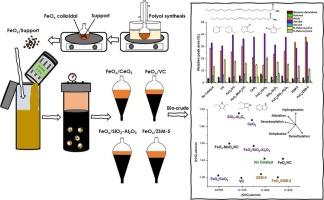各种支持物对氧化铁纳米催化剂上食物垃圾水热液化的影响的启示
IF 10.1
1区 工程技术
Q1 ENERGY & FUELS
引用次数: 0
摘要
本研究探讨了支持性氧化铁纳米催化剂对食物垃圾水热转化的影响。所研究的支撑物有火神碳(VC)、CeO2、ZSM-5 和无定形 SiO2-Al2O3。不同的 Fe(0)、Fe2+ 和 Fe3+ 分量会改变其脱氧、加氢和缩合反应的倾向,从而影响生物原油的产量、元素组成和能量回收率。使用 X 射线光电子能谱、物理吸附分析、热重分析、透射和扫描电子显微镜对新鲜催化剂和废催化剂进行了表征。研究发现,催化剂载体的变化会影响 HTL 的路径和产物成分。研究结果表明,在 Vulcan 炭、SiO2-Al2O3 和 ZSM-5 载体上加入 FeOx 催化剂可使生物原油产量比不含 FeOx 的产量提高约 7-9 wt%。在 0.8-1.6 的范围内,生物原油产量的增加与 Fe3+/Fe2+ 表面比的降低有关。总的来说,更倾向于将胺转化为油溶性化合物的催化剂提高了生物原油产量,而促进脱水和脱羧路线的催化剂则降低了生物原油产量。使用 FeOx/SiO2-Al2O3 催化剂获得的生物原油能量回收率最高,达到约 95%。催化剂失活与催化位点上 Ca 和 P 有毒元素的增加有关,这使得再生 FeOx/SiO2-Al2O3 催化剂的能量回收率在三个循环后降至约 85%。本文章由计算机程序翻译,如有差异,请以英文原文为准。

Insights into the effect of various supports on hydrothermal liquefaction of food waste over iron-oxide nano-catalysts
This work investigates the effect of supported iron-oxide nano-catalysts for hydrothermal conversion of food waste. The studied supports were Vulcan carbon (VC), CeO2, ZSM-5 and amorphous SiO2-Al2O3. Catalytic hydrothermal liquefaction experiments were carried out in a batch reactor at 16 MPa and 300 °C maintained for 1 h. Different fractions of Fe(0), Fe2+ and Fe3+ alter its tendency toward deoxygenation, hydrogenations and condensation reactions, which influence the bio-crude yield, elemental compositions, and energy recoveries. The fresh and spent catalysts were characterized using X-ray photoelectron spectroscopy, physisorption analysis, thermogravimetric analysis, transmission and scanning electron microscopy. It was found that the change in catalyst support influences HTL pathways and product compositions. The results reveal that the inclusion of FeOx catalyst on Vulcan carbon, SiO2-Al2O3 and ZSM-5 supports can increase the bio-crude yield by ~7–9 wt% compared to their FeOx-free yields. The increase in bio-crude yield was associated with the decrease in the surface ratios of Fe3+/Fe2+ at the range of 0.8–1.6. In overall, catalysts that had higher tendencies in converting amines into oil-soluble compounds increased the bio-crude yield, while catalysts that promoted dehydration and decarboxylation route decreased the bio-crude yield. The maximum energy recovery in bio-crude was obtained using FeOx/SiO2-Al2O3 catalyst with values ~95 %. The deactivation of catalysts was associated with the increase in Ca and P poisonous elements on catalytic sites, which decreased the energy recovery of recycled FeOx/SiO2-Al2O3 to ~85 % after three cycles.
求助全文
通过发布文献求助,成功后即可免费获取论文全文。
去求助
来源期刊

Applied Energy
工程技术-工程:化工
CiteScore
21.20
自引率
10.70%
发文量
1830
审稿时长
41 days
期刊介绍:
Applied Energy serves as a platform for sharing innovations, research, development, and demonstrations in energy conversion, conservation, and sustainable energy systems. The journal covers topics such as optimal energy resource use, environmental pollutant mitigation, and energy process analysis. It welcomes original papers, review articles, technical notes, and letters to the editor. Authors are encouraged to submit manuscripts that bridge the gap between research, development, and implementation. The journal addresses a wide spectrum of topics, including fossil and renewable energy technologies, energy economics, and environmental impacts. Applied Energy also explores modeling and forecasting, conservation strategies, and the social and economic implications of energy policies, including climate change mitigation. It is complemented by the open-access journal Advances in Applied Energy.
 求助内容:
求助内容: 应助结果提醒方式:
应助结果提醒方式:


